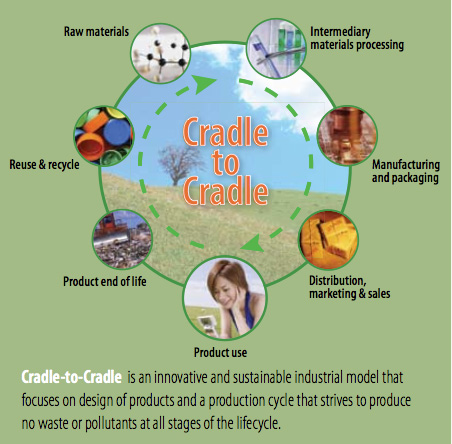
The Cradle to Cradle (C2C) idea has been around for a good decade now, longer if we’d track it right back to its inception. The first C2C fabric was developed sometime in the early 2000s, and flies now around the world as upholstery fabric on the A380 Airbus models. Interestingly, fashion – or maybe more accurately: textiles – would be an ideal discipline in which the concept could blossom with relatively little effort (always in comparison to other industries). The textile industry relies to large degree on resources that are in its origin organic – even man-made fibres are generally oil based at their origin.
C2C Case Studies in textiles: Who does what, and where?
Until only a couple of years ago, the number of designer and textile manufacturers either incorporating or, even better, committing to the C2C concept could be counted on the fingers of one hand. Strange enough, the last 24 months have given life to a much more advanced and developed landscape, where ever more designers and manufacturers offer solutions that adhere to C2C principles. It is equally interesting that certainly most designers are Nordic (Scandinavia, Denmark, Holland), yet the manufacturers are mostly – but not exclusively – central European.
Here are a few examples – but by no means exhaustive – of the most known and recognised C2C designers and manufacturers in the textile arena.
Designers:
- Dutch Spirit [Dutch & German only]: Is a label that creates sporty casual clothing perfect for everyday wear, both for women as well as men. The label is the behind the rain coat pictures in the introduction to this article. Beyond C2C they also commit to the whole width and breadth of ethical principles, from fair labour, to organic crop farming.
- Trigema is a sport and casual wear manufacturer. Their C2C T-Shirt line, which is created such that it is even safe for human consumption. While the company produces in Germany, they struggled to come up with an attractive design for the T-shirt, and which would justify the initially elevated price for the T-shirt. The problem has been recognised since and newer editions seem to have remedied the lack of a compelling design. By now the company carries 2 full lines of C2C garments: The Trigema Wellness line and the Trigema Change line.
- Swedish Designer Matilda Wendelboe was in fact the first designer globally to launch a C2C collection, and she has kept with the commitment since, choosing her materials accordingly.
- The world’s first children’s wear label is equally Swedish. Bonkeli Design, a family apparel designer company, launched their C2C baby and children’s range in late 2010 and have since kept to their commitment. They evidently capitalise on the fact that many children’s ranges, including from very expensive high-end labels, use not only high levels of obnoxious chemicals, but that children’s clothing does get ripped eventually beyond repair and cannot be handed down any more. It is known that Swedes prefer solutions that are all around ecological rather than to ‘just’ opt for the 2nd-hand-donation track creating waste at some point or other in the waste disposal chain.
Manufacturers:
- US based Victor Innovatex’s Eco Intelligent Polyester have been certified against the C2C Gold Standard level. The fabrics are designed to be perpetually recyclable in a closed loop system.
- The Swiss company Gessner’s ClimaTex LifeGuard and LifeCycle upholstery fabrics – the LifeGuard line is flown prominently around the world in the A380 Airbus – were the globally first textile products ever that became C2C compliant. These fabrics are produced in a closed loop system, and production waste fibres are popular among the farmers of the surrounding communities to fertilize their fields.
- The Danish company Gabriel produces with their Gaia C2C series a crepe-type upholstery fabric which is following the C2C concept.
- Backhausen from Austria has developed the first flame retardant C2C fabric (called Returnity) with properties equal to Trevira CS. This is in as far an important step as most European health & safety standards resulted in a de facto requirement to treat certain fabrics – notably for interiors and upholstery – with toxic flame retardant chemicals.
- The US based Pendleton Woollen Mill developed their Eco-Wise Wool® Apparel Fabric which now is used not only in apparel but also interiors. This is in as far important when you know that woollens normally take up to 7 years to decompose (and creates significant amount of waste water, and hence potential pollution, in the scouring process), but with C2C the same process takes under the same conditions only about 6 months, and the scouring process is heavily controlled.
- The Venezuelan Jeantex has swapped over their full range of Indigo Denim fabrics over to C2C. This specifically includes: Heavy, 100% cotton weight of 12.5 oz and 14.5 oz; medium 100% cotton or polyester blend, weighing between 10.5 oz 12 oz; light, 100% cotton or polyester blend, weight between 7 oz and 10 oz; and a stretch fabric with a mixture of polyester and Lycra.
While the C2C certification unfortunately has been turned into a money churning commercial enterprise by the 2 original founders of the concept (list of certified products, incl. rating), the idea as such is certainly logical and compelling.
Compelling enough that designers and manufacturers are able to implement it independently without requiring a proprietary certification body. And verifiable for anyone with enough technical knowledge to run a few tests with the help of a children’s’ chemistry tool box and a compost heap.
Video: 1st Cradle-to-Cradle Fashion Show, Berlin, Germany, 11th of March 2011

